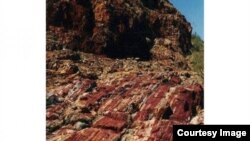Tiny glass beads scientists have discovered on what used to be ocean floor tell the tale of a giant asteroid that hit the earth billions of years ago.
The beads are called spherules and scientists from the Australian National University found them in far Northwestern Australia.
The asteroid 20 to 30 kilometers across would have left a crater hundreds of kilometers wide when it hit.
That's a big asteroid
A rock that size would also, have triggered "earthquakes orders of magnitude greater than terrestrial earthquakes," according scientist Andrew Glikson. "It would have caused huge tsunamis and would have made cliffs crumble."
The debris from such a huge impact Glikson says would also have spread around the world. But the constant movement and volcanic activity of our home planet would have obliterated any clues to where it hit.
The oceans of the moon, called mare are the remains of similar sized rocks that hit our lunar companion between 3.8 and 3.9 billion years ago, so it makes sense that a few would have been pulled to earth.
So instead of looking for craters, the scientists looked for the vaporized materials that would have been thrown into the atmosphere and coated the planet.
What they found were these tiny spherules of glass, heavy with metals like platinum, nickel and chromium that match up with the elements we find inside most asteroids.
Scientific dating methods put the impact date at about 3.46 billion years ago.
Glikson has been looking for impacts like these for 20 years and he has found about 17, but he thinks there could have been hundreds, some strong enough to change the way the earth evolved.









